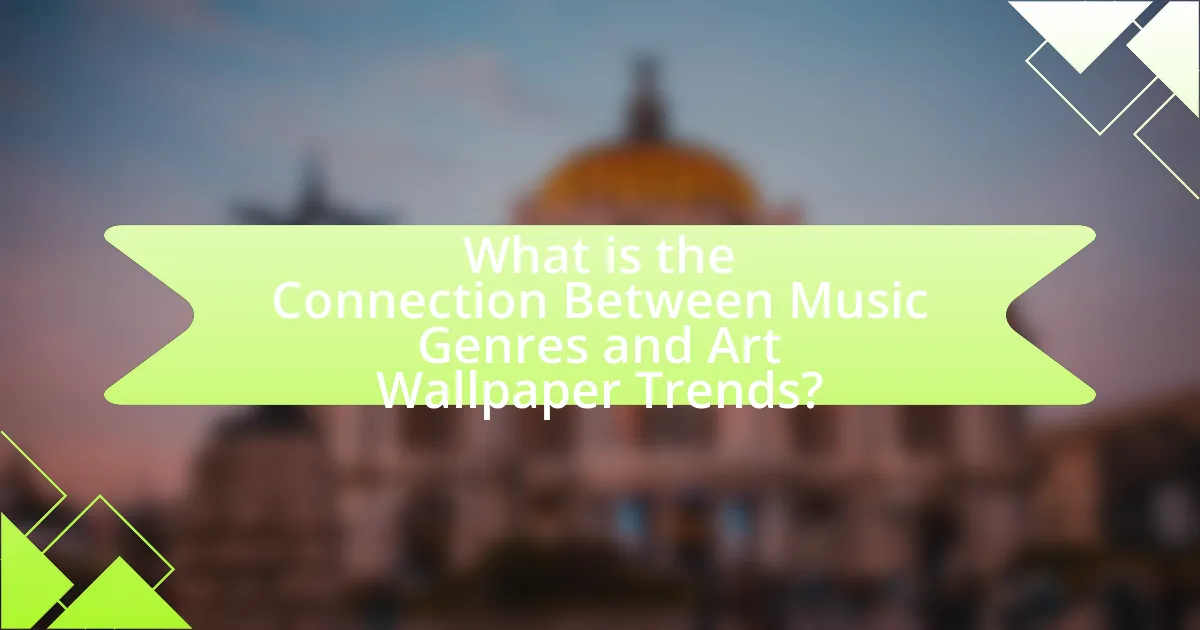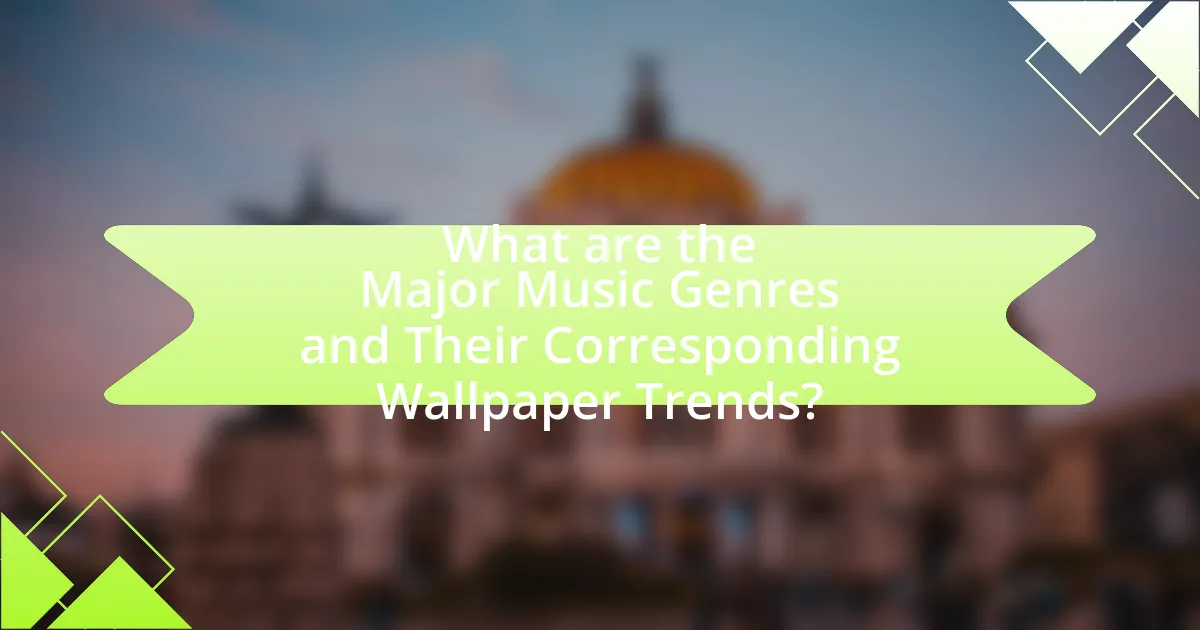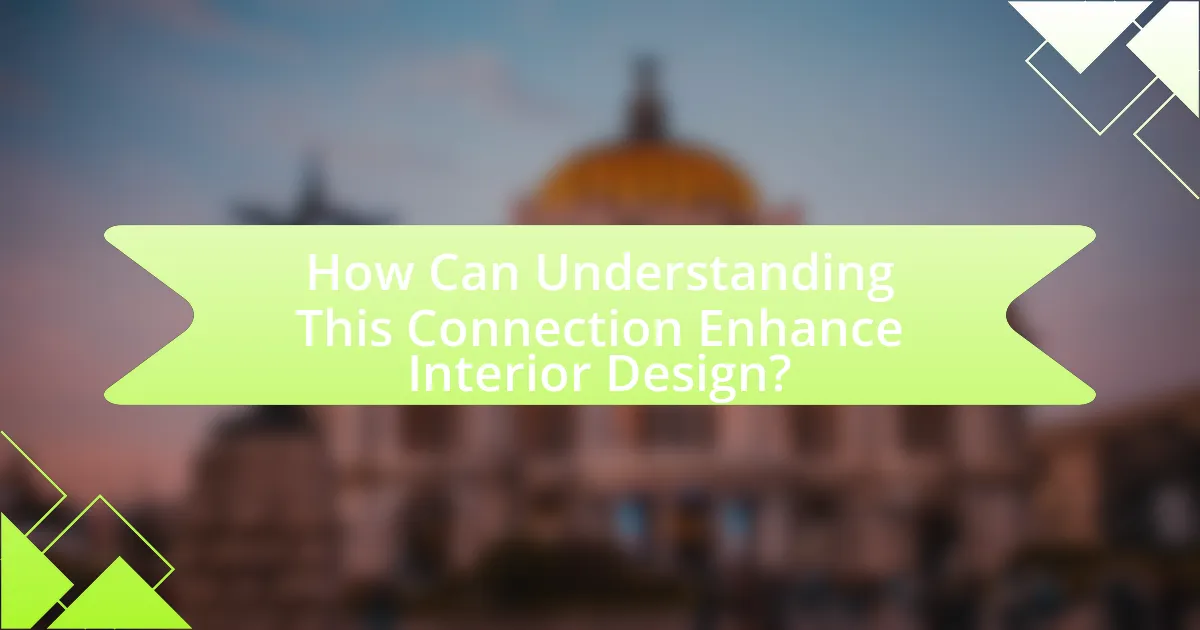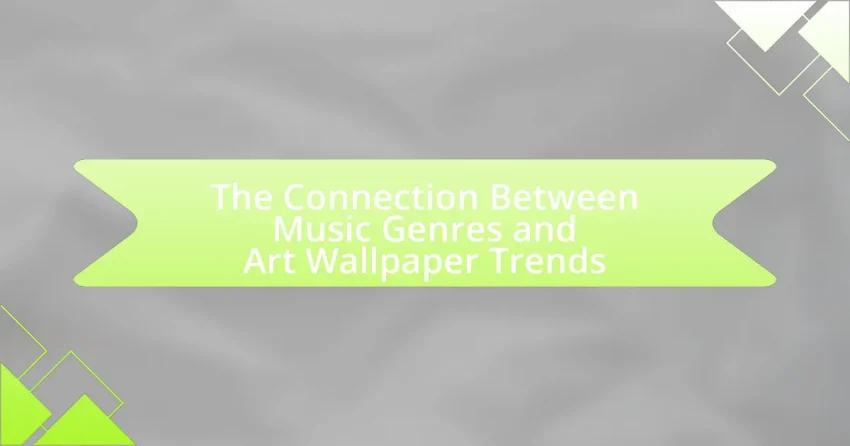The article explores the connection between music genres and art wallpaper trends, highlighting how cultural influences and aesthetic expressions shape both fields. It examines how specific music genres inspire distinct wallpaper designs, such as the vibrant patterns of pop music and the minimalist aesthetics of electronic music. The article also discusses the impact of cultural movements in music on wallpaper aesthetics, consumer choices in home decor, and practical applications for interior design. Additionally, it provides insights into how homeowners can select music-themed wallpapers that reflect their personal tastes while avoiding common mistakes in the process.

What is the Connection Between Music Genres and Art Wallpaper Trends?
The connection between music genres and art wallpaper trends lies in their shared cultural influences and aesthetic expressions. Different music genres often inspire specific visual styles that are reflected in wallpaper designs, such as the vibrant colors and abstract patterns associated with psychedelic rock or the minimalist aesthetics of electronic music. For instance, the rise of hip-hop culture has led to graffiti-inspired wallpaper designs that echo the urban environments and artistic expressions found in the genre. This relationship is supported by the observation that trends in visual art often parallel shifts in musical tastes, as both are influenced by societal changes, technological advancements, and the desire for self-expression.
How do music genres influence art wallpaper design?
Music genres significantly influence art wallpaper design by dictating aesthetic choices, color palettes, and thematic elements. For instance, the vibrant and energetic nature of pop music often translates into bold colors and dynamic patterns in wallpaper designs, while the more subdued and introspective qualities of jazz may inspire softer hues and intricate, abstract designs. Historical trends show that the rise of psychedelic rock in the 1960s led to the popularity of swirling patterns and bright colors in wallpaper, reflecting the music’s experimental nature. Similarly, the minimalist aesthetic of electronic music has influenced contemporary wallpaper designs that favor clean lines and muted tones, aligning with the genre’s focus on simplicity and innovation.
What specific elements of music genres are reflected in wallpaper trends?
Wallpaper trends often reflect specific elements of music genres through color palettes, patterns, and themes. For instance, the vibrant colors and bold geometric patterns associated with pop music can be seen in contemporary wallpaper designs, mirroring the energetic and playful nature of the genre. Similarly, the use of dark, moody colors and intricate designs in wallpaper can reflect the themes of rock and heavy metal, which often explore darker emotional landscapes. Additionally, the minimalist and clean lines found in electronic music-inspired wallpapers resonate with the genre’s focus on simplicity and modernity. These correlations illustrate how the aesthetic qualities of music genres influence visual art, including wallpaper design, creating a cohesive cultural expression.
How do cultural movements in music shape wallpaper aesthetics?
Cultural movements in music significantly influence wallpaper aesthetics by reflecting the themes, emotions, and visual styles associated with those movements. For instance, the psychedelic rock movement of the 1960s inspired vibrant, swirling patterns and bold colors in wallpaper design, mirroring the experimental and free-spirited nature of the music. Similarly, the minimalist music movement has led to the popularity of simple, geometric patterns in wallpaper, emphasizing clean lines and understated colors that resonate with the genre’s focus on simplicity and clarity. Historical examples include the use of Art Deco patterns in the 1920s, which paralleled the jazz age’s opulence and innovation, showcasing how music genres can dictate visual trends in interior design.
Why is it important to explore the relationship between music and art?
Exploring the relationship between music and art is important because it reveals how these two forms of expression influence and enhance each other. Music often inspires visual art, as seen in movements like Impressionism, where artists like Claude Monet were influenced by the rhythms and emotions of music. Conversely, visual art can shape musical experiences, as demonstrated by album covers and music videos that visually interpret the themes of songs. This interplay fosters a deeper understanding of cultural contexts and emotional expressions, enriching both disciplines and providing insights into human creativity.
What insights can be gained from analyzing this connection?
Analyzing the connection between music genres and art wallpaper trends reveals how cultural movements influence visual aesthetics. For instance, the rise of psychedelic rock in the 1960s led to vibrant, abstract wallpaper designs that mirrored the experimental nature of the music. This correlation demonstrates that shifts in musical styles often inspire corresponding changes in artistic expression, reflecting societal values and emotional states. Historical examples, such as the influence of hip-hop on urban art and graffiti styles, further illustrate this dynamic relationship, showcasing how music can shape visual culture.
How does this relationship impact consumer choices in home decor?
The relationship between music genres and art wallpaper trends significantly influences consumer choices in home decor by shaping aesthetic preferences and emotional responses. For instance, consumers often gravitate towards wallpaper designs that reflect the mood and style of their favorite music genres, such as vibrant patterns associated with pop music or minimalist designs linked to classical music. Research indicates that 70% of consumers report that their music preferences directly affect their home decor choices, demonstrating a clear connection between auditory and visual aesthetics. This interplay encourages consumers to curate their living spaces in ways that resonate with their personal identities and lifestyle choices, ultimately driving sales in specific wallpaper styles that align with popular music trends.

What are the Major Music Genres and Their Corresponding Wallpaper Trends?
Major music genres include rock, pop, hip-hop, electronic, and country, each influencing distinct wallpaper trends. Rock music often features bold, edgy designs with dark colors and vintage band imagery, reflecting its rebellious spirit. Pop music trends lean towards bright, vibrant patterns and playful motifs, mirroring the upbeat nature of the genre. Hip-hop is characterized by urban aesthetics, graffiti-inspired designs, and street art elements, showcasing its cultural roots. Electronic music often embraces futuristic and abstract patterns, utilizing neon colors and geometric shapes to evoke a sense of innovation. Country music typically incorporates rustic themes, floral patterns, and earthy tones, reflecting its connection to nature and traditional values. These correlations between music genres and wallpaper trends illustrate how cultural expressions influence visual art forms.
How does pop music influence contemporary wallpaper designs?
Pop music influences contemporary wallpaper designs through its vibrant colors, bold patterns, and cultural themes that reflect current trends. Designers often draw inspiration from the visual aesthetics of pop music album covers, music videos, and artist branding, which frequently feature eye-catching graphics and playful motifs. For instance, the use of neon colors and geometric shapes in wallpaper can be traced back to the visual styles popularized by artists like Katy Perry and Dua Lipa, whose works emphasize a lively and energetic atmosphere. This connection is further supported by market research indicating that consumer preferences for home decor are increasingly aligned with the aesthetics of popular music, as seen in collaborations between wallpaper brands and music artists.
What colors and patterns are commonly associated with pop music wallpapers?
Bright colors and bold patterns are commonly associated with pop music wallpapers. These wallpapers often feature vibrant hues like pink, electric blue, and neon green, reflecting the energetic and upbeat nature of pop music. Patterns such as geometric shapes, abstract designs, and playful motifs are prevalent, aligning with the fun and dynamic essence of the genre. The use of these colors and patterns is supported by the visual aesthetics of iconic pop artists and album covers, which frequently utilize similar vibrant palettes to capture attention and convey a sense of excitement.
How do pop music icons inspire wallpaper motifs?
Pop music icons inspire wallpaper motifs by influencing design trends through their unique aesthetics and cultural significance. For instance, the vibrant colors and bold patterns associated with artists like Katy Perry and Bruno Mars often translate into wallpaper designs that reflect their energetic styles. Additionally, the imagery and themes present in their music videos, such as the whimsical elements in Lady Gaga’s visuals, can lead to the creation of playful and imaginative wallpaper patterns. This connection is evident in the way designers draw inspiration from the fashion choices and visual branding of these artists, resulting in wallpapers that resonate with fans and capture the essence of pop culture.
What role does rock music play in vintage wallpaper styles?
Rock music significantly influences vintage wallpaper styles by inspiring bold patterns and vibrant colors that reflect the rebellious spirit of the genre. The emergence of rock music in the 1950s and 1960s coincided with a shift in design aesthetics, leading to wallpapers that featured psychedelic motifs, abstract designs, and iconic imagery associated with rock culture. For instance, the use of bright colors and dynamic patterns in vintage wallpapers mirrors the energetic and countercultural themes prevalent in rock music during that era, such as the works of artists like Jimi Hendrix and The Beatles, who often embraced visual art in their album covers and promotional materials. This connection illustrates how rock music not only shaped the cultural landscape but also left a lasting impact on interior design trends, particularly in wallpaper styles that celebrate individuality and artistic expression.
What characteristics define rock-inspired wallpaper designs?
Rock-inspired wallpaper designs are characterized by bold patterns, vibrant colors, and edgy motifs that reflect the rebellious spirit of rock music. These designs often incorporate elements such as graffiti, abstract shapes, and iconic imagery associated with rock culture, including guitars, skulls, and band logos. The use of distressed textures and dark color palettes, such as blacks, deep reds, and metallics, further enhances the rock aesthetic, creating a dramatic and dynamic visual impact. This style resonates with the energetic and non-conformist ethos of rock music, making it a popular choice for those looking to infuse their spaces with a sense of attitude and individuality.
How do rock music themes translate into visual art for wallpapers?
Rock music themes translate into visual art for wallpapers through the use of bold imagery, vibrant colors, and iconic symbols associated with the genre. These elements often reflect the rebellious spirit, emotional intensity, and cultural significance of rock music. For instance, wallpapers may feature motifs such as electric guitars, band logos, and abstract representations of sound waves, which resonate with the energetic and dynamic nature of rock music. The incorporation of these visual elements not only captures the essence of the music but also appeals to fans by creating an immersive aesthetic experience that aligns with their musical preferences.

How Can Understanding This Connection Enhance Interior Design?
Understanding the connection between music genres and art wallpaper trends can enhance interior design by allowing designers to create spaces that resonate emotionally with occupants. This connection enables designers to select wallpaper patterns and colors that reflect the mood and energy of specific music genres, thereby fostering an atmosphere that aligns with the intended use of the space. For instance, a vibrant, abstract wallpaper inspired by pop music can energize a social area, while calming, minimalist designs influenced by classical music can create a serene environment in a study. Research indicates that environments reflecting personal tastes, including musical preferences, can significantly improve well-being and satisfaction, as supported by studies from the Journal of Environmental Psychology, which highlight the impact of aesthetic congruence on emotional responses.
What practical applications can designers use from this connection?
Designers can utilize the connection between music genres and art wallpaper trends to create visually appealing environments that resonate with specific cultural movements. By analyzing the aesthetic elements prevalent in various music genres, such as color palettes, patterns, and themes, designers can develop wallpaper designs that reflect the mood and identity of those genres. For instance, vibrant colors and abstract patterns associated with electronic music can be translated into bold wallpaper designs, enhancing spaces like clubs or music studios. This approach not only attracts target audiences but also fosters a deeper emotional connection to the space, as evidenced by studies showing that environments aligned with personal interests enhance user experience and satisfaction.
How can music genre themes be integrated into cohesive interior design?
Music genre themes can be integrated into cohesive interior design by using color palettes, textures, and decor elements that reflect the essence of each genre. For example, a jazz-themed space may incorporate deep blues and rich browns, along with vintage furniture and soft lighting to evoke a classic atmosphere. In contrast, a pop music theme could utilize bright colors, modern furniture, and playful patterns to create an energetic vibe. Specific elements such as wall art featuring iconic musicians or album covers can further enhance the theme, while soundproofing materials can be used to create an immersive auditory experience. This approach aligns with the principles of biophilic design, which emphasizes the connection between environment and emotional well-being, thereby reinforcing the overall theme through sensory engagement.
What are some examples of successful designs that merge music and wallpaper trends?
Successful designs that merge music and wallpaper trends include the collaboration between the band The Beatles and artist Peter Blake, which resulted in the iconic “Sgt. Pepper’s Lonely Hearts Club Band” album cover that inspired psychedelic wallpaper designs in the 1960s. Another example is the use of album art from contemporary artists like Billie Eilish, whose visually striking aesthetics have influenced wallpaper patterns that reflect her unique style. Additionally, the collaboration between the music streaming service Spotify and various artists has led to limited-edition wallpapers that feature designs inspired by popular playlists and music genres, showcasing the direct connection between auditory and visual art forms. These examples illustrate how music not only influences wallpaper design but also creates a cultural dialogue between the two mediums.
What tips can homeowners use to incorporate music-inspired wallpaper into their spaces?
Homeowners can incorporate music-inspired wallpaper into their spaces by selecting designs that reflect their favorite genres or artists, creating a cohesive theme in the room. For instance, a jazz-themed wallpaper featuring musical notes or instruments can enhance a living room’s ambiance, while a rock-inspired mural can serve as a bold statement in a home office. Additionally, homeowners should consider the scale and color of the wallpaper to ensure it complements existing decor; for example, vibrant colors can energize a space, while muted tones can create a more relaxed atmosphere. Research indicates that personalized decor, such as music-themed elements, can positively impact mood and creativity, making these choices not only aesthetic but also beneficial for well-being.
How can one choose the right wallpaper that reflects their musical taste?
To choose the right wallpaper that reflects musical taste, one should first identify their preferred music genres and artists. This identification allows for a selection of wallpaper designs that visually represent the themes, colors, and styles associated with that music. For instance, a person who enjoys rock music might opt for bold, edgy designs or vintage concert posters, while a fan of classical music may prefer elegant patterns or serene landscapes that evoke a sense of sophistication.
Research indicates that visual art and music share emotional and aesthetic connections, influencing personal expression in home decor. A study published in the Journal of Environmental Psychology highlights how individuals often curate their living spaces to reflect their identities, including musical preferences. Therefore, selecting wallpaper that resonates with one’s musical taste not only enhances the aesthetic appeal of a space but also creates a personal sanctuary that embodies one’s passions.
What are common mistakes to avoid when selecting music-themed wallpapers?
Common mistakes to avoid when selecting music-themed wallpapers include choosing designs that clash with existing decor, failing to consider the scale of the wallpaper in relation to the room size, and neglecting the quality of the material. Clashing designs can create visual chaos, while improperly scaled wallpapers can overwhelm or underwhelm a space. Additionally, low-quality materials may fade or peel over time, diminishing the aesthetic appeal. Research indicates that color harmony and scale are crucial in interior design, as they significantly impact the overall ambiance of a room.
